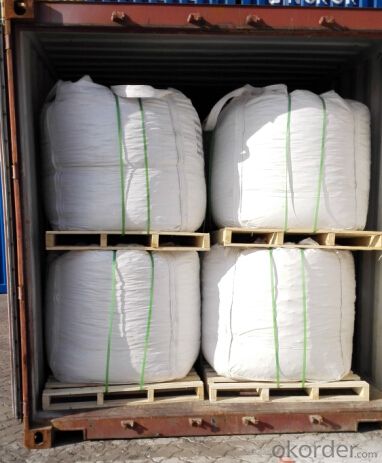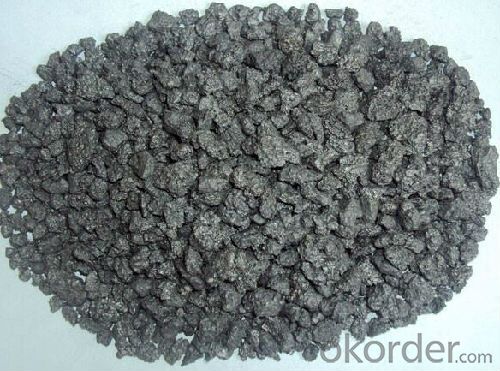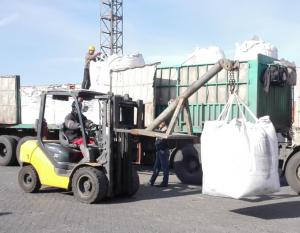High FC Carbon Coke FC98% from CNBM China
- Loading Port:
- Tianjin
- Payment Terms:
- TT or LC
- Min Order Qty:
- 20 m.t.
- Supply Capability:
- 1500 m.t./month
OKorder Service Pledge
OKorder Financial Service
You Might Also Like
Packaging & Delivery
| Packaging Detail: | 50kg/bag 100kg/bag 1000kg/bag Or according with client need to do |
| Delivery Detail: | 2 weeks |
Specifications
High FC Carbon Coke FC98% from CNBM China
Petroleum coke products can be divided into needle coke, sponge coke, projectile coke and coke breeze four kinds.
Calcined Petroleum Coke
F.C.: 98.5%MIN
ASH: 0.8% MAX
V.M.: 0.7%MAX
S:0.5%MAX
Moisture: 0.5%MAX
Structure
High FC Carbon Coke FC98% from CNBM China
Shape: granule
Dimensions: 0-1mm, 1-5mm, 1-6mm, 2-8mm, etc
Product Type: Carbon Additive
C Content (%): 98-99.5% MIN
Working Temperature: -
S Content (%): 0.5%-0.7%MAX
Ash Content (%): 0.7%MAX
Volatile:0.8%MAX
Moisture: 0.5% MAX
ADVANTAGE: low ash & sulfur
COLOR: Black
Feature
High FC Carbon Coke FC98% from CNBM China
Physics and chemistry performance:
Unit | Index | |||||
No.1 | No.2 | No.3 | ||||
Density | g/cm3 | 2.04 | 2.00 | 2.00 | ||
sulphur content | %≤ | 0.5 | 1.0 | 2.5 | ||
volatility | %≤ | 0.5 | 0.5 | 0.5 | ||
ash content | %≤ | 0.5 | 0.5 | 0.5 | ||
moisture | %≤ | 0.3 | 0.5 | 0.5 | ||
charcoal | %≤ | 98.5 | 98.0 | 98.0 | ||
Image
High FC Carbon Coke FC98% from CNBM China


FAQ:
High FC Carbon Coke FC98% from CNBM China
How to classify calcined petroleum coke?
1) According to difference of sulfur content, can be divided into high sulfur coke (sulfur content more than 4%), sulphur in coke sulfur content (2% 4%) and low sulfur coke (sulfur content below 2%).
2) Petroleum coke products can be divided into needle coke, sponge coke, projectile coke and coke breeze four kinds:
3) Needle coke, has obvious needle-like structure and fiber texture, mainly used for steel-making in high power and ultra-high power graphite electrode. As a result of needle coke in sulfur content, ash content, volatile matter and true density and so on have strict quality requirements, so the production process of needle coke and raw materials have special requirements.
4) The sponge coke, high chemical reactivity, low content of impurities, mainly used in the aluminum industry and carbon industry.
5) Focal or spherical coke: the projectile shape is round, diameter 0.6-30 mm, usually from the production of high sulphur, high asphaltic residual oil, can only be used as industrial fuel power generation, cement etc.
6) Coke breeze: fluidized coking process, the fine particles (0.1- 0.4 mm) in diameter, high volatile, high expansion coefficient, cannot be directly used for electrode preparation and carbon industry.
Advantage:
High FC Carbon Coke FC98% from CNBM China
1. High quality and competitive price.
2. Timely delivery.
3. If any item you like. Please contact us.
Your sincere inquiries are typically answered within 24 hours.
- Q:Well, recently, the carbon cycle has suddenly come up with a lot of questions. What's the definition of carbon and light carbon? What are the characteristics, and what are the differences between the two?
- Light and heavy soil organic matter is divided according to the proportion of the isolates used in this study. The proportion of 1.7 is the proportion of < 1.7 for light fraction organic matter, the proportion of > 1.7 recombinant organic matter. The composition and decomposition of organic carbon in different components are significantly different. Light fraction organic matter by no solution complete plant residues and its fractions include a small amount of live microorganisms or their secretions, is susceptible to microbial decomposition and utilization characteristics, is very sensitive to climatic and environmental changes and agricultural management measures, is the active carbon pool in soil.
- Q:I just decoration, do not understand, JS run, please feel free to show.
- Carbon fiber in Yuba last year is very fire, but this year the world's gold tube Yuba, Yuba carbon fiber words this year to buy a cheaper, less than 300 will be shipping home...LED is currently the most high-end gold tube Yuba, adopts imported nano powder coating technology and U type stainless steel mirror groove in the original gold tube bath on the basis of the upgrade, the pipe also bold thickening, the heating effect is very good. There are intelligent temperature control equipment, very safe.... The biggest characteristic is that the lighting has been replaced by LED lighting, which is the best lighting equipment at present... Industry is in the starting stage, like the rain the sun came out only at the end of June, now a lot cheaper to buy, will certainly increase the business trick,
- Q:What should we do to reduce carbon emissions in our lives?
- Reducing the burning of fossil fuels is important, reducing the emission of motor vehicles, reducing private cars, reducing thermal power, and burning carbon emissions from coal-fired power plants
- Q:How does carbon affect the migration patterns of birds?
- Carbon emissions and the resultant climate change have a significant impact on the migration patterns of birds. The increase in carbon dioxide levels in the atmosphere leads to global warming, which affects various environmental factors such as temperature, precipitation, and vegetation growth. These changes directly influence the availability of food, water, and suitable habitats for birds during their migratory journeys. One of the key ways carbon affects bird migration is by altering the timing and duration of seasonal events. For instance, warmer temperatures can cause plants to bloom earlier or delay their growth, disrupting the synchronized timing of flowering and the arrival of insects. This can have serious consequences for birds that rely on these resources for food during their migration. If birds arrive at their breeding grounds or stopover sites and find a lack of food, it can lead to decreased survival rates, reduced reproductive success, and overall population decline. Additionally, changes in precipitation patterns due to carbon emissions can affect the availability of water sources along migration routes. Birds rely on these water bodies for drinking and bathing, especially during long flights. If these water sources dry up or become scarce, it can force birds to alter their flight paths, search for alternative water sources, or even risk dehydration. Furthermore, carbon-induced changes in vegetation cover can impact the availability of suitable habitats for birds. As temperatures rise, some bird species may face challenges in finding suitable breeding or nesting sites. Forest-dwelling birds, for example, may experience habitat loss as forests are degraded or replaced by drier ecosystems. This can disrupt their migratory patterns and potentially lead to population declines or range shifts. Overall, the impact of carbon emissions on bird migration patterns is complex and multifaceted. As climate change continues to unfold, it is crucial to mitigate carbon emissions and implement conservation measures to ensure the survival and well-being of migratory bird populations. Protecting crucial stopover sites, promoting habitat restoration, and raising awareness about the consequences of carbon emissions can all contribute to preserving the intricate and vital phenomenon of bird migration.
- Q:How does deforestation contribute to carbon dioxide levels in the atmosphere?
- Increased carbon dioxide levels in the atmosphere are significantly influenced by deforestation. Trees play a crucial role as natural carbon sinks, absorbing carbon dioxide through photosynthesis and storing it in their trunks, branches, and leaves. However, when forests are cleared or burned down for purposes like agriculture, logging, or urbanization, the stored carbon is released back into the atmosphere as carbon dioxide. The removal of trees directly diminishes the planet's ability to absorb carbon dioxide, resulting in an imbalance in the carbon cycle. Furthermore, deforestation disrupts the carbon cycle by hindering the process of photosynthesis, which is vital for converting carbon dioxide into oxygen and organic compounds. Additionally, deforestation indirectly contributes to increased carbon dioxide levels in the atmosphere through the decomposition of organic matter. When trees are cut down or burned, the stored carbon they contain is released as carbon dioxide, intensifying greenhouse gas emissions. Moreover, deforestation impacts the water cycle, leading to dryer conditions in affected areas. This causes soil to become arid, making it less suitable for plant growth and reducing the potential for carbon absorption through reforestation efforts. The cumulative effect of deforestation on carbon dioxide levels is significant. Studies indicate that deforestation accounts for approximately 10-15% of global carbon emissions, thus making it one of the leading contributors to climate change. The rise in atmospheric carbon dioxide levels, along with other greenhouse gases, contributes to the greenhouse effect, trapping heat in the atmosphere and causing global warming. To mitigate climate change and decrease carbon dioxide levels, it is crucial to address deforestation. Implementing sustainable forestry practices, promoting reforestation efforts, and protecting existing forests are essential steps in preserving carbon sinks and reducing greenhouse gas emissions.
- Q:What are the effects of carbon emissions on agriculture?
- Agriculture is significantly harmed by carbon emissions, with various negative effects. Firstly, the presence of higher levels of carbon dioxide (CO2) in the atmosphere contributes to global warming, resulting in changes in rainfall patterns and more frequent occurrences of extreme weather events like droughts, floods, and heatwaves. These weather conditions disrupt agricultural production by reducing crop yields, damaging crops, and increasing the prevalence of pests and diseases. Higher temperatures also accelerate evaporation, which leads to soil moisture deficits and water scarcity. This has a detrimental impact on crop growth and productivity. Additionally, elevated CO2 levels can modify the nutritional composition of crops, reducing their quality and nutritional value. Research has demonstrated that increased CO2 concentrations can decrease the protein content in wheat and rice, potentially causing health issues for those who heavily rely on these staple crops. Moreover, carbon emissions contribute to the formation of ground-level ozone, a harmful air pollutant. Ozone damages plant cells, inhibits photosynthesis, and reduces crop yields. It particularly affects sensitive crops such as soybeans, wheat, and cotton. The consequences of carbon emissions on agriculture extend beyond crop production. Livestock farming is also affected, as rising temperatures and water scarcity make it more difficult to maintain adequate grazing lands and provide sufficient water and fodder for animals. Furthermore, changes in climate patterns can facilitate the spread of livestock diseases and pests, posing additional risks to the livestock industry. In conclusion, carbon emissions have far-reaching effects on agriculture, resulting in decreased crop yields, diminished nutritional value, challenges in livestock farming, and increased vulnerability to pests, diseases, and extreme weather events. It is crucial to address and mitigate carbon emissions to safeguard global food security and ensure the sustainability of agricultural systems.
- Q:How does carbon affect the formation of acid rain?
- Carbon does not directly affect the formation of acid rain. Acid rain is primarily caused by emissions of sulfur dioxide and nitrogen oxides, which react with water, oxygen, and other chemicals in the atmosphere to form sulfuric acid and nitric acid. However, carbon dioxide, a greenhouse gas emitted from the burning of fossil fuels, contributes to climate change. Climate change can alter weather patterns and increase the frequency and intensity of precipitation, which can indirectly affect the acidity of rain.
- Q:How does carbon affect the properties of steel?
- Carbon is a crucial element in the production of steel and plays a significant role in determining its properties. The amount of carbon present in steel has a direct impact on its hardness, strength, and overall performance. By adding carbon to iron, the base metal of steel, it becomes significantly stronger and more durable. This is because the carbon atoms are able to occupy the spaces between iron atoms, preventing the metal from sliding or deforming easily. The higher the carbon content, the harder and stronger the steel becomes. Moreover, carbon also influences the steel's ability to be heat treated and its response to various manufacturing processes. When steel is heated and rapidly cooled, a process known as quenching, the presence of carbon allows for the formation of harder and more brittle structures, such as martensite. On the other hand, lower carbon content allows for the formation of softer and more ductile structures. In addition to its impact on strength and hardness, carbon also affects the steel's corrosion resistance. Higher carbon content can lead to reduced corrosion resistance, making the steel more susceptible to rust and other forms of degradation. This is why stainless steel, which contains a higher amount of chromium and low carbon content, is often chosen for applications where corrosion resistance is crucial. To summarize, carbon greatly influences the properties of steel. It enhances its strength and hardness, allows for heat treatment and response to manufacturing processes, and affects its corrosion resistance. The careful control of carbon content in steel is vital in order to achieve the desired properties for specific applications.
- Q:What are the main factors that affect the strength of carbon fibers?
- [Abstract]: the interface play on the properties of carbon fiber composite material plays a very important role, the composite load transfer through the interface, can make the carbon fiber and the matrix to form an effective performance of the whole. In the study of the interface, improving the bonding strength is the key to improve the mechanical properties of the carbon fiber composite. Therefore, it is very important to analyze the influence of various factors on the interfacial bonding strength of carbon fiber reinforced composites for improving the comprehensive properties of composites. In this paper, by using scanning electron microscopy (SEM), X ray photoelectron spectroscopy (XPS), laser Raman spectroscopy (LRS), X ray diffraction (XRD) and Fu Liye transform infrared spectroscopy (FTIR) and mechanical testing technology, investigated the effect of different preparation processes on the structure and properties of carbon fiber, discusses the evolution of the structure and properties of the carbon fiber surface process and electrochemical treatment in the process of electrochemical modification prepared by wet spinning PAN based carbon fiber, the carbon fiber surface except the rationality of glue craft, in-depth study of the carbon fiber electrochemical treatment, sizing agent and matrix modification effect on the bonding strength of carbon fiber composite the carbon fiber material, electrochemical modification mechanism and matrix modification mechanism.
- Q:How does carbon affect the ozone layer?
- Carbon does not directly affect the ozone layer. However, certain carbon compounds, such as chlorofluorocarbons (CFCs) and hydrochlorofluorocarbons (HCFCs), can indirectly contribute to the depletion of the ozone layer. These compounds contain chlorine and bromine atoms, which are released into the atmosphere when the compounds are broken down by sunlight. Once in the atmosphere, chlorine and bromine atoms can catalytically destroy ozone molecules, leading to a thinning of the ozone layer. When a chlorine or bromine atom comes into contact with an ozone molecule, it reacts with it, breaking it apart and forming a chlorine or bromine oxide molecule and a regular oxygen molecule. The chlorine or bromine oxide molecule can then react with another ozone molecule, continuing the cycle and depleting the ozone layer. While carbon itself does not directly contribute to ozone depletion, the production and release of carbon compounds like CFCs and HCFCs result from human activities. These compounds were widely used in various industries, such as refrigeration, air conditioning, and aerosol propellants, until it was discovered that they were harmful to the ozone layer. The Montreal Protocol, an international treaty signed in 1987, aimed to phase out the production and use of these ozone-depleting substances. Reducing carbon emissions, however, is crucial in addressing another environmental concern – climate change. High levels of carbon dioxide and other greenhouse gases in the atmosphere trap heat, leading to global warming. This poses various threats to ecosystems and human societies. By transitioning to cleaner and more sustainable energy sources and implementing measures to reduce carbon emissions, we can tackle both ozone depletion and climate change, safeguarding the health of our planet.
1. Manufacturer Overview |
|
|---|---|
| Location | |
| Year Established | |
| Annual Output Value | |
| Main Markets | |
| Company Certifications | |
2. Manufacturer Certificates |
|
|---|---|
| a) Certification Name | |
| Range | |
| Reference | |
| Validity Period | |
3. Manufacturer Capability |
|
|---|---|
| a)Trade Capacity | |
| Nearest Port | |
| Export Percentage | |
| No.of Employees in Trade Department | |
| Language Spoken: | |
| b)Factory Information | |
| Factory Size: | |
| No. of Production Lines | |
| Contract Manufacturing | |
| Product Price Range | |
Send your message to us
High FC Carbon Coke FC98% from CNBM China
- Loading Port:
- Tianjin
- Payment Terms:
- TT or LC
- Min Order Qty:
- 20 m.t.
- Supply Capability:
- 1500 m.t./month
OKorder Service Pledge
OKorder Financial Service
Similar products
New products
Hot products































